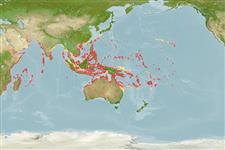Actinopterygii (ray-finned fishes) >
Perciformes (Perch-likes) >
Lethrinidae (Emperors or scavengers) > Lethrininae
Etymology: Lethrinus: Greek, lethrinia, a fish pertaining to genus Pagellus.
Environment / Climate / Range
Ecology
Marine; brackish; reef-associated; non-migratory; depth range 0 - 20 m (Ref. 9710). Tropical, preferred 28°C (Ref. 107945); 32°N - 32°S, 31°E - 155°W
Indo-West Pacific: Red Sea and East Africa to Samoa, north to southern Japan, south to northeastern Australia.
Length at first maturity / Size / Weight / Age
Maturity: Lm 19.5 range ? - 21.1 cm
Max length : 50.0 cm TL male/unsexed; (Ref. 2295); common length : 30.0 cm TL male/unsexed; (Ref. 30573); max. reported age: 15 years (Ref. 2293)
Dorsal
spines
(total): 10;
Dorsal
soft rays
(total): 9;
Anal
spines: 3;
Anal
soft rays: 8. Mouth slightly protractile; lips thick and fleshy. Inner base of pectorals densely covered with scales. Color is olive-green dorsally, paler ventrally; scales on back sometimes with white center. A large elliptical blotch, often broadly edged in yellow, on side directly below lateral line and centered at a vertical near the posterior tip of the pectoral fin. Sometimes light blue dots border the lower rime of the eye and around the nostrils. The pectoral, pelvic, dorsal and anal fins are white to pinkish. The caudal fin is orange or reddish. The vertical fins are sometimes lightly mottled or stripped.
Found solitary or in small schools over shallow sandy, coral rubble, mangroves, lagoons, channel and seagrass areas inshore and adjacent to coral reefs. Feeds on polychaetes, crustaceans, mollusks, echinoderms and small fish. Reported to spawn throughout the year during the first five days of the lunar month in large aggregations in Palau. Marketed fresh (Ref. 171); flesh spoils rapidly (Ref. 4369).
Life cycle and mating behavior
Maturity | Reproduction | Spawning | Eggs | Fecundity | Larvae
Carpenter, K.E. and G.R. Allen, 1989. FAO Species Catalogue. Vol. 9. Emperor fishes and large-eye breams of the world (family Lethrinidae). An annotated and illustrated catalogue of lethrinid species known to date. FAO Fish. Synop. 125(9):118 p. Rome: FAO. (Ref. 2295)
IUCN Red List Status (Ref. 115185)
CITES (Ref. 94142)
Not Evaluated
Threat to humans
Harmless
Human uses
Fisheries: commercial
More information
ReferencesAquacultureAquaculture profileStrainsGeneticsAllele frequenciesHeritabilityDiseasesProcessingMass conversion
Tools
Special reports
Download XML
Internet sources
